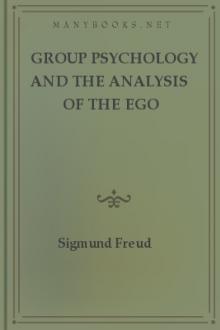Group Psychology and The Analysis of The Ego by Sigmund Freud (top 5 ebook reader .TXT) 📕

- Author: Sigmund Freud
- Performer: -
Book online «Group Psychology and The Analysis of The Ego by Sigmund Freud (top 5 ebook reader .TXT) 📕». Author Sigmund Freud
FURTHER PROBLEMS AND LINES OF WORK
We have hitherto considered two artificial groups and have found that they are dominated by two emotional ties. One of these, the tie with the leader, seems (at all events for these cases) to be more of a ruling factor than the other, which holds between the members of the group.
Now much else remains to be examined and described in the morphology of groups. We should have to start from the ascertained fact that a mere collection of people is not a group, so long as these ties have not been established in it; but we should have to admit that in any collection of people the tendency to form a psychological group may very easily become prominent. We should have to give our attention to the different kinds of groups, more or less stable, that arise spontaneously, and to study the conditions of their origin and of their dissolution. We should above all be concerned with the distinction between groups which have a leader and leaderless groups. We should consider whether groups with leaders may not be the more primitive and complete, whether in the others an idea, an abstraction, may not be substituted for the leader (a state of things to which religious groups, with their invisible head, form a transition stage), and whether a common tendency, a wish in which a number of people can have a share, may not in the same way serve as a substitute. This abstraction, again, might be more or less completely embodied in the figure of what we might call a secondary leader, and interesting varieties would arise from the relation between the idea and the leader. The leader or the leading idea might also, so to speak, be negative; hatred against a particular person or institution might operate in just the same unifying way, and might call up the same kind of emotional ties as positive attachment. Then the question would also arise whether a leader is really indispensable to the essence of a group—and other questions besides.
But all these questions, which may, moreover, have been dealt with in part in the literature of Group Psychology, will not succeed in diverting our interest from the fundamental psychological problems that confront us in the structure of a group. And our attention will first be attracted by a consideration which promises to bring us in the most direct way to a proof that libidinal ties are what characterize a group.
Let us keep before our eyes the nature of the emotional relations which hold between men in general. According to Schopenhauer's famous simile of the freezing porcupines no one can tolerate a too intimate approach to his neighbour.[34]
The evidence of psycho-analysis shows that almost every intimate emotional relation between two people which lasts for some time—marriage, friendship, the relations between parents and children[35]—leaves a sediment of feelings of aversion and hostility, which have first to be eliminated by repression. This is less disguised in the common wrangles between business partners or in the grumbles of a subordinate at his superior. The same thing happens when men come together in larger units. Every time two families become connected by a marriage, each of them thinks itself superior to or of better birth than the other. Of two neighbouring towns each is the other's most jealous rival; every little canton looks down upon the others with contempt. Closely related races keep one another at arm's length; the South German cannot endure the North German, the Englishman casts every kind of aspersion upon the Scotchman, the Spaniard despises the Portuguese. We are no longer astonished that greater differences should lead to an almost insuperable repugnance, such as the Gallic people feel for the German, the Aryan for the Semite, and the white races for the coloured.
When this hostility is directed against people who are otherwise loved we describe it as ambivalence of feeling; and we explain the fact, in what is probably far too rational a manner, by means of the numerous occasions for conflicts of interest which arise precisely in such intimate relations. In the undisguised antipathies and aversions which people feel towards strangers with whom they have to do we may recognize the expression of self-love—of narcissism. This self-love works for the self-assertion of the individual, and behaves as though the occurrence of any divergence from his own particular lines of development involved a criticism of them and a demand for their alteration. We do not know why such sensitiveness should have been directed to just these details of differentiation; but it is unmistakable that in this whole connection men give evidence of a readiness for hatred, an aggressiveness, the source of which is unknown, and to which one is tempted to ascribe an elementary character.[36]
But the whole of this intolerance vanishes, temporarily or permanently, as the result of the formation of a group, and in a group. So long as a group formation persists or so far as it extends, individuals behave as though they were uniform, tolerate other people's peculiarities, put themselves on an equal level with them, and have no feeling of aversion towards them. Such a limitation of narcissism can, according to our theoretical views, only be produced by one factor, a libidinal tie with other people. Love for oneself knows only one barrier—love for others, love for objects.[37] The question will at once be raised whether community of interest in itself, without any addition of libido, must not necessarily lead to the toleration of other people and to considerateness for them. This objection may be met by the reply that nevertheless no lasting limitation of narcissism is effected in this way, since this tolerance does not persist longer than the immediate advantage gained from the other people's collaboration. But the practical importance of the discussion is less than might be supposed, for experience has shown that in cases of collaboration libidinal ties are regularly formed between the fellow-workers which prolong and solidify the relation between them to a point beyond what is merely profitable. The same thing occurs in men's social relations as has become familiar to psycho-analytic research in the course of the development of the individual libido. The libido props itself upon the satisfaction of the great vital needs, and chooses as its first objects the people who have a share in that process. And in the development of mankind as a whole, just as in individuals, love alone acts as the civilizing factor in the sense that it brings a change from egoism to altruism. And this is true both of the sexual love for women, with all the obligations which it involves of sparing what women are fond of, and also of the desexualised, sublimated homosexual love for other men, which springs from work in common. If therefore in groups narcissistic self-love is subject to limitations which do not operate outside them, that is cogent evidence that the essence of a group formation consists in a new kind of libidinal ties among the members of the group.
But our interest now leads us on to the pressing question as to what may be the nature of these ties which exist in groups. In the psycho-analytic study of neuroses we have hitherto been occupied almost exclusively with ties that unite with their objects those love instincts which still pursue directly sexual aims. In groups there can evidently be no question of sexual aims of that kind. We are concerned here with love instincts which have been diverted from their original aims, though they do not operate with less energy on that account. Now we have already observed within the range of the usual sexual object-cathexis [Objektbesetzung] phenomena which represent a diversion of the instinct from its sexual aim. We have described them as degrees of being in love, and have recognized that they involve a certain encroachment upon the ego. We shall now turn our attention more closely to these phenomena of being in love, in the firm expectation of finding in them conditions which can be transferred to the ties that exist in groups. But we should also like to know whether this kind of object-cathexis, as we know it in sexual life, represents the only manner of emotional tie with other people, or whether we must take other mechanisms of the sort into account. As a matter of fact we learn from psycho-analysis that there do exist other mechanisms for emotional ties, the so-called identifications, insufficiently-known processes and hard to describe, the investigation of which will for some time keep us away from the subject of Group Psychology.
VIIIDENTIFICATION
Identification is known to psycho-analysis as the earliest expression of an emotional tie with another person. It plays a part in the early history of the Oedipus complex. A little boy will exhibit a special interest in his father; he would like to grow like him and be like him, and take his place everywhere. We may say simply that he takes his father as his ideal. This behaviour has nothing to do with a passive or feminine attitude towards his father (and towards males in general); it is on the contrary typically masculine. It fits in very well with the Oedipus complex, for which it helps to prepare the way.
At the same time as this identification with his father, or a little later, the boy has begun to develop a true object-cathexis towards his mother according to the anaclitic type [Anlehnungstypus].[38] He then exhibits, therefore, two psychologically distinct ties: a straightforward sexual object-cathexis towards his mother and a typical identification towards his father. The two subsist side by side for a time without any mutual influence or interference. In consequence of the irresistible advance towards a unification of mental life they come together at last; and the normal Oedipus complex originates from their confluence. The little boy notices that his father stands in his way with his mother. His identification with his father then takes on a





Comments (0)